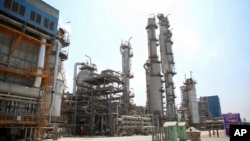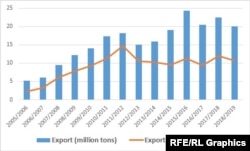An Iranian official announced April 13 that the country’s total exports of petrochemical products during the last fiscal year stood at 20 million tons, worth $10.645 billion. Iran’s fiscal year ended March 20.
Taghi Sanei, the head of Nouri Petrochemical Company -- majority owned by government-- didn’t mention whether U.S. sanctions affected this sector or not, but according to official statistics, released by state-run National Iranian Petrochemical Company (NIPC), the country exported 22.4 million tons of petrochemical products worth more than $12 billion during the previous Iranian year (March 21 2017-March 20, 2018).
Therefore, Iran’s petrochemical exports declined by 10.7% in volume and 13% in value during 2018-2019 when the Trump administration reimposed economic sanctions on Tehran..
The United States withdrew from the 2015 nuclear agreement with Iran last May and imposed financial, industrial and oil-related sanctions in the second half of 2018.
NIPC’s monthly statistics indicate that before U.S. sanctions, during January-June 2018, the country’s petrochemical exports were slightly above the first half of 2017, but in the second half, exports started declining.
For instance, during March 21-January 21, Iran’s petrochemical exports declined only 4.4% year-on-year, but during January 21-March 20 2019, the volume declined more than 28% year-on-year and pushed the whole annual exports 10.7% below the previous year.
Iran’s petrochemical products export since a fiscal year to March 2005:
Source: NIPC
Iran’s petrochemicals export increased rapidly during 2005-2012, but the international sanctions imposed in 2011 decreased the trade during 2012-2016. After 2016 when sanctions were lifted, the volume increased even above pre-sanctions level, but as a result of lower oil and petrochemical prices (prices has plunged mid-2014), the value of Iran’s petrochemicals exports never reached pre-sanctions level.
How exporters receive payments?
The U.S. has banned the use of its currency for any trade with Iran, and the Islamic Republic uses other ways to receive money for both oil and non-oil exports.
An industry source, who wants to remain anonymous, told Radio Farda that currently Iranian petrochemical exporters don’t receive any payments in U.S. dollars, but use mostly the euro and United Arab Emirates’ dirham for cash payments. They also use NIMA currency exchange system for payments.
NIMA is Persian acronym for Integrated System for Hard Currency Transactions.
The Central Bank of Iran has recently established NIMA, forcing exporters to wire their hard currency earnings back to special accounts of an unofficial network, not much different from the Havala (Hawala) system. It is basically a non-banking system of transferring largely untraceable money through corresponding money-handling outfits.
But once the money reaches NIMA, exporters receive local currency in Iran based on a much lower rate than what they would get on the open market in Tehran. Similarly, importers who need hard currency to make purchases abroad, receive much cheaper dollars from the government, through the same system.
It is not clear if the hard currency handed over to NIMA stays outside Iran and is transferred to importers’ accounts abroad or is partially repatriated to Iran, most probably in cash deliveries.
The source said that the USD rate in NIMA system is about half of its value in Iran’s open markets (which is currently above 140,000 rials to the dollar), which makes exporters reluctant to deliver their earnings abroad to NIMA system.
An ongoing corruption trial in Iran shows that during international sanctions, 2011-2016, the Iranian government allowed private actors to engage in all kinds of wheeling and dealings to export petrochemicals illegally and consequently profit from the sanctions-busting activity.
Petrochemicals role in non-oil exports
Petrochemicals are Iran’s second biggest industry after oil and gas and constitute about one fifth of total non-oil exports.
According to official statistics, before Islamic Republic was established in 1979, Iran was annually producing 1.6 million tons of petrochemicals, but now it stands at above 53 million tons, but the figure includes semi-raw products which petrochemical plants sell to one another for producing value-added final products.
The real volume of finished products is estimated to be below 30 million tons a year, with 8.5 million tons sold domestically.
U.S. sanctions have already damaged this sector. During 2017/2018 fiscal year, about 16% of Iran’s nominal petrochemical production capacity was idle, but during the first nine months of the last Iranian fiscal year (March 2018-January 2019), about 29% of the capacity remained idle.
There is no information yet about production for the full fiscal year, but considering the decline in exports, idle capacity has likely increased.






